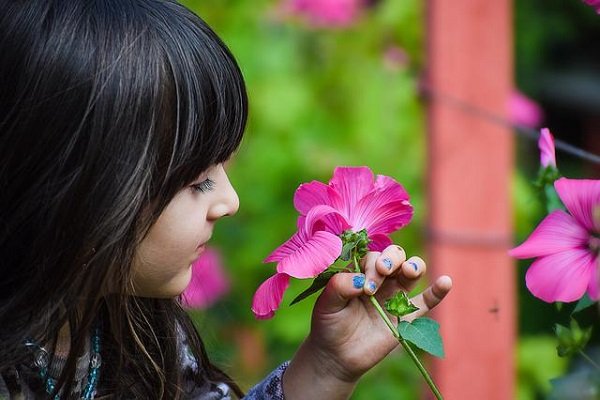Written by Aviva Tulasi
The last couple of years have been filled with intense events. And lately we have been experiencing an onslaught of tragedies that anger and scare many of us. Each week might seem as though there is more negative news looming. Intense negative emotions such as anger and fear are important to protect us. And it is important to recognize our emotional response. However, living in this intense negative state can take a toll on the mind and the body. Therefore we need tools to reduce the intense negative emotions and return to a state of calm to promote clarity of what is true. What’s an easy tool to use? Slow Breathing with an Extended Exhale.
Surprised? Even though I am a yoga teacher who always starts yoga classes with breathing to tune inward, I was surprised that slow diaphragmatic breathing (AKA abdominal breathing) is a solution to shift away from my fear response in a matter of minutes. Experiencing intense anger or fear, can feel like you are losing control or that the emotion will never end. But as I recently experienced, if you can observe the emotion, then shift your attention to the movement of the belly and start to breathe slowly through the nostrils, you can experience a reduction in the negative emotion.
Our emotions are linked to our breathing. When experiencing anxiety or fear the breath is quick and shallow. In stark contrast, when you are relaxed or meditating the breath is slow and steady almost undetectable. The correlations between the breath and emotional state link our sympathetic (stress pathway) and parasympathetic (relaxation pathway) nervous system responses with our breath. Studies suggest that longer exhalations are an easy way to activate the vagus nerve (nerve connecting the brain, senses and stomach believed to turn on the relax and digest mechanism in the body), combat fight-or-flight stress responses, and improve HRV (heart rate variability). Although the exact mechanism for why a long exhalation activates the vagus nerve and promotes relaxation is unclear, researchers are starting to explore biomechanical feedback mechanisms. There is a positive feedback loop between the lungs, the heart and the brain that releases neurotransmitters that signal the activation of the parasympathetic nervous system. Some ideas are that stretching of the lungs, pressure on the blood vessels or the slowing of the heart rate send messages to the brain. No matter what the exact mechanism is, when we take deep breaths, the vagus nerve turns on the parasympathetic nervous system.
Intellectual knowledge doesn’t always translate into practical applications. I know the value of abdominal breathing, but when I had a memory that elicited an extreme negative stress response, I had no idea how to get out of it. I was frozen. My chest hurt. I could not stop replaying the memory. My therapist told me to breathe slowly with a long exhale. As soon as I allowed the breath to slowly seep out through my nose, the memory started to fade and the fear I had just been experiencing was gone.
Really, that was it. Slow extended exhalation breathing changed my mindset in a matter of minutes. It might seem simple but it takes practice. It is very easy to lose focus on the breath. And it takes time to develop control of abdominal muscles to allow you to breathe slowly.
For the month of June, you can practice slow extended exhalation using this Guided Extended Exhalation in our video library for free with discount code SlowExhale. If you have a Green, Gold or Platinum membership you won’t need to enter the discount code.
To experience the link between slow extended exhalation and reduction in intense emotion, Bo Forbes, PsyD suggests Worrying and 1:2 breathing in the book Yoga for Emotional Balance. Before practicing this exercise you should have a good understanding of your breathing pattern and have practiced breathing with a long exhale.
Worrying and 1:2 Breathing Exercise
Notice how you feel and the quality of the breath.
Think of something that worries you or makes you angry.
For example, being late or someone not changing an empty toilet paper roll.
Take a couple of minutes noticing how the thought irritates you.
Focus on breathing.
Breathe in and out through your nose.
Slowly start to extend the exhale until it is twice as long as the inhale.
If you notice anxiety or other discomfort, shorten the exhale.
After a few minutes of breathing slowly with a long exhale, notice how you feel.
The yoga classes at Dogwood Studio help build awareness of your emotions, how you feel about your emotions and of your breath. Classes such as Mindful Movement and Yoga promote great insights as to how we hold tension, move (or do not move) our bodies, and how we relate to the sensations in the body. All of our yoga classes give you the flexibility to attend how you are most comfortable: In Person, Online and on demand video library.
Our video library allows you to practice at times convenient for you. This is a great way to keep up with your practice if you are traveling or find your summer schedule does not allow you to attend live classes.
In June there are two special class series: Herbal Yoga with Ainslee and PhysioYoga with Jacob. Both class series build a greater awareness of your movement and connection to the world we live in. You do not need to attend previous classes to join for a specific week; each class is a stand alone opportunity to explore. Come for one, some or all.
Reach out to us via email with any questions or comments at info@dogwoodstudioyoga.com.
Aviva Chaye Tulasi is a team member at Dogwood Studios. She is a certified yoga therapist (C-IAYT). She applies the teachings of classical yoga to reduce the effects of negative stress and to balance the nervous system. Aviva is available for private sessions. Email Aviva at yogawithtulasi@gmail.com with any questions.
SAM Sather, founder of Dogwood Studios, is a certified yoga therapist (C-IAYT), individualizes the yoga practice with appropriate modifications for participants’ unique bodies and medical histories with a focus on finding calm and improving health. She offers several live, online and in person yoga classes as well as private sessions so you can focus on your needs one-on-one.


